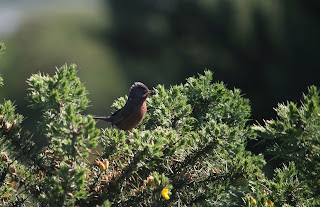Dartford Warblers
Dartford Warblers (Sylvia undata) are among the scarcest and most enigmatic passerines to grace these islands, and surely among the most charming. When vast tracts of heathland covered much of Southern England, the species was not uncommon, and it is named for Dartford Heath in North Kent, from which it has been absent for decades. Perhaps more at home in Mediterranean Europe, it is on the edge of its range in Great Britain. With the increasing development and fragmentation of this habitat, sitting as it does in desirable Surrey and Dorset, it underwent decades of decline. It is also said to be particularly vulnerable to predation by domestic cats, which can exclude it from small scraps of habitat saved from housing developments. An exclusive insectivore, and largely sedentary species, its greatest enemy is the British winter, persistent snow can wipe a colony out, and a cold winter in the early 1960s nearly did for the British population entirely, just a few pairs appearing after the snow finally melted. However, amid great conservation effort and with possibly a small helping hand from climate change, the species is beginning to recover.
Dartford Warblers (Sylvia undata) are among the scarcest and most enigmatic passerines to grace these islands, and surely among the most charming. When vast tracts of heathland covered much of Southern England, the species was not uncommon, and it is named for Dartford Heath in North Kent, from which it has been absent for decades. Perhaps more at home in Mediterranean Europe, it is on the edge of its range in Great Britain. With the increasing development and fragmentation of this habitat, sitting as it does in desirable Surrey and Dorset, it underwent decades of decline. It is also said to be particularly vulnerable to predation by domestic cats, which can exclude it from small scraps of habitat saved from housing developments. An exclusive insectivore, and largely sedentary species, its greatest enemy is the British winter, persistent snow can wipe a colony out, and a cold winter in the early 1960s nearly did for the British population entirely, just a few pairs appearing after the snow finally melted. However, amid great conservation effort and with possibly a small helping hand from climate change, the species is beginning to recover.
 |
| Dartford Warbler at Arne. |
 |
| A view from Arne. |
It was at the RSPB’s magnificent pristine heathland reserve at Arne, near Wareham in Dorset, that I had my most recent, and most magical encounter with these gorgeous little passerines. A solo expedition to one of my favourite corners of the country in the hope of catching up with Nightjar (I did, but not enough to blog about), I camped near this magnificent spot, a large tract of Dorset coastal heath on Poole Harbour overlooking Brownsea Island, managed impeccably for conservation, and took a long stroll among its heathland rides. Arne was abuzz with dragonflies and butterflies and hoverflies, and 90 common spotted orchids grew along the bank of one small pond which must have hosted half a dozen different Odonata, including an iridescent Downy Emerald and a striking pair of Emperors including an Ovipositing female. It was becoming a good day.
 |
| Emperor Dragonfly (Anax imperator) ovipositing at Arne. |
It was the song of the Dartford Warbler that first caught my attention. Imagine the song of a Whitethroat (Sylvia communis), and consider the qualities and notes which ensure the song is often described as “scratchy.” Now distil those scratchy qualities, concentrate that Sylvia scratchiness, andyou will begin to imagine the song of the male Dartford Warbler. The male caught my eye first too, a small, dark coloured bird, with a longish tail, proportions somewhere between a Cetti’s Warbler and a Long Tailed Tit. He alighted briefly at the top of the heather, sang a few notes, and dropped back into the thick tangle of waist high vegetation. He reappeared and my eyes strained to see his features in the sun glare, his dark blue-grey back and wings contrasting little with his dark pink-red underparts, and he had an air of cultivated scruffiness. Rooting in the gorse he popped up briefly with a beak full of spiders, before dropping down to stuff his spiders into the expectant mouth of a scruffy fledgling, brown and distinctly smaller than the adult, which had emerged from the vegetation. The fledglings and the female never left the thick heather and gorse, appearing to my eye only briefly before returning to the shelter of the thick heather canopy, but the male returned to his commanding lookout and sang, re-stating his claim to this his fragment of the coastal heath, the precious resource upon which his family depend. Perhaps by remaining in this prominent position he also provided a distraction display focussing the attention of birders, and any would-be predators, on him, allowing the more vulnerable youngsters to slip away.
It was a magical moment with these scruffy, charismatic little survivors, and conservation icons of the lowland heath. It was heartening to know that, with many small birds finding their breeding cycles disrupted by the late snow this spring, at least some of this most cold-sensitive warblers had successfully fledged broods. This family appeared to be doing well.

